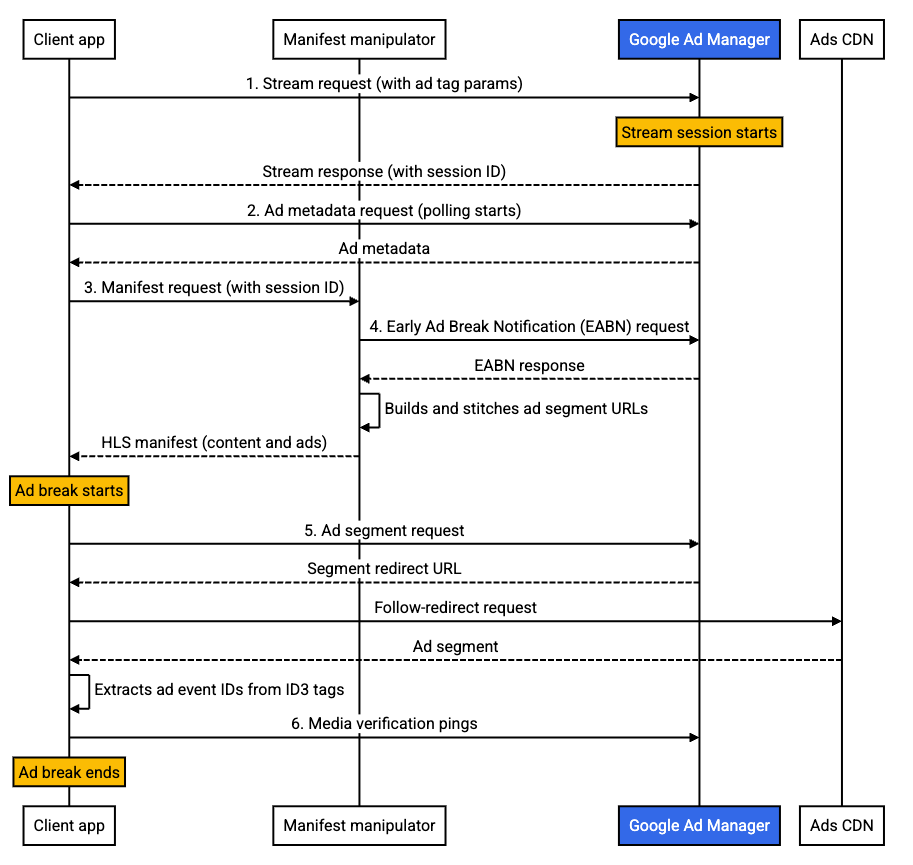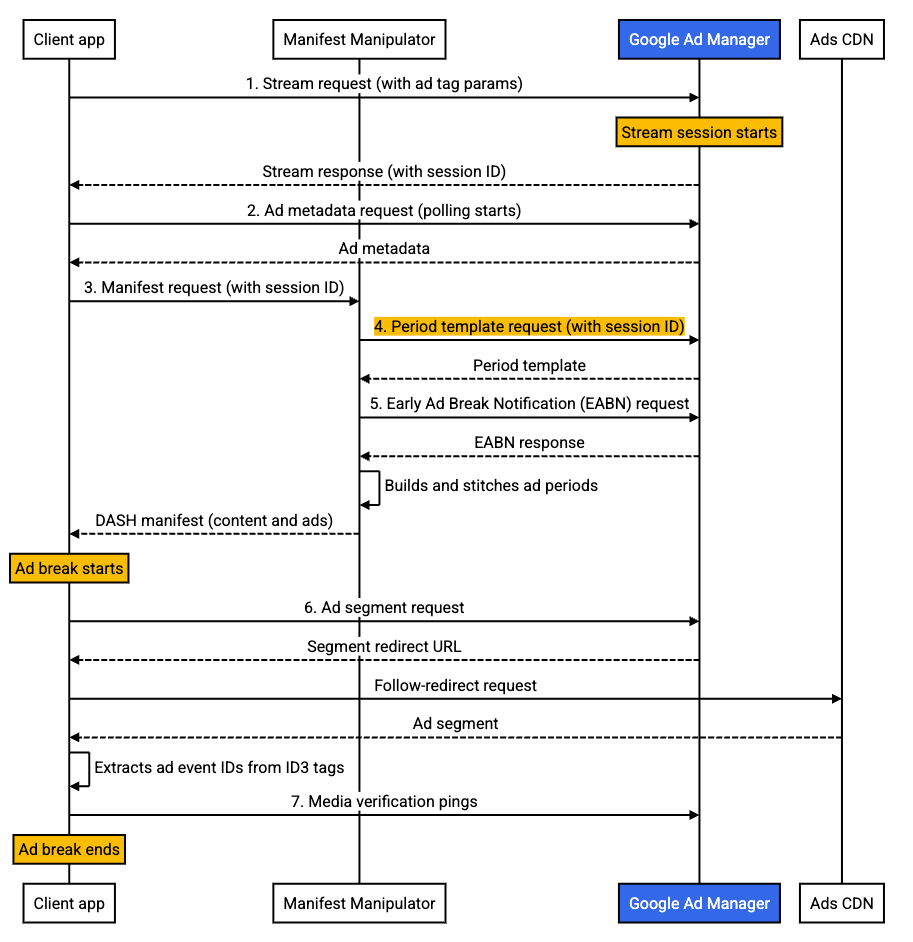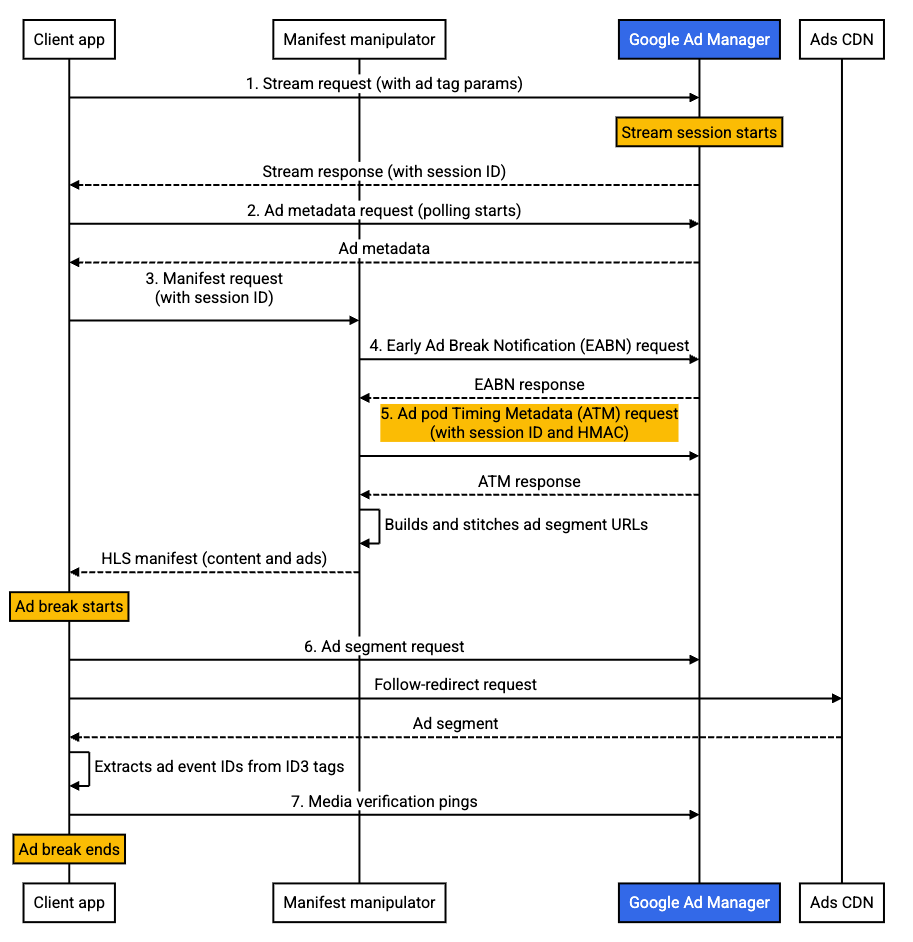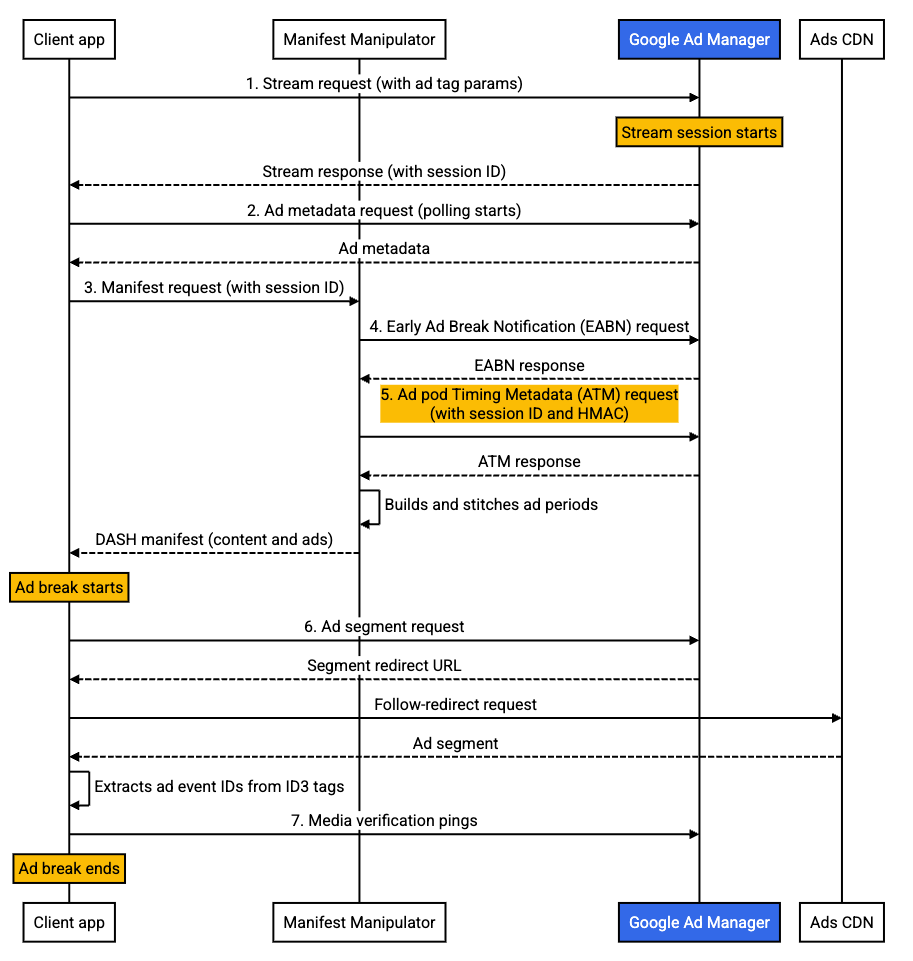หากต้องการใช้การแทรกโฆษณาฝั่งเซิร์ฟเวอร์ (SSAI) กับสตรีมแบบสด HLS หรือ DASH ให้ใช้ Pod Serving API เพื่อขอพ็อดโฆษณาที่มีบิตเรตแบบปรับได้ ดูความละเอียดและอัตราบิตที่รองรับได้ที่รูปแบบและการแปลงวิดีโอและเสียง
หน้านี้ครอบคลุมการใช้ Pod Serving API สำหรับไลฟ์สด
ข้อกำหนดเบื้องต้น
คุณต้องมีสิ่งต่อไปนี้ก่อนดำเนินการต่อ
กำหนดค่ากิจกรรมไลฟ์สดด้วยประเภทการแทรกโฆษณาแบบไดนามิก (DAI) ที่เปลี่ยนเส้นทางการแสดงในพ็อด เลือกตัวเลือกใดตัวเลือกหนึ่งต่อไปนี้
- ตั้งค่าไลฟ์สดสำหรับ DAI
- เลือกไลบรารีของไคลเอ็นต์ SOAP API แล้วเรียกใช้เมธอด
LiveStreamEventService.createLiveStreamEventsด้วยออบเจ็กต์LiveStreamEventและตั้งค่าประเภทdynamicAdInsertionTypeเป็นPOD_SERVING_REDIRECTenum สำหรับไลบรารีของไคลเอ็นต์ทั้งหมด โปรดดูไลบรารีของไคลเอ็นต์และโค้ด ตัวอย่าง
แอปไคลเอ็นต์ที่ทํางานในเว็บเบราว์เซอร์ อุปกรณ์เคลื่อนที่ หรือทีวี เพื่อโหลดสตรีมและจัดการเหตุการณ์ต่างๆ เช่น เล่น หยุดชั่วคราว คลิก หรือแตะ
ตัวจัดการ Manifest เพื่อจัดการคำขอสตรีมจากแอปไคลเอ็นต์ สำคัญ: สำหรับบริการ Manifest เราขอแนะนำขั้นตอนการแสดงโฆษณาขั้นสูง
บัญชี Google Ad Manager ที่เปิดใช้ DAI แบบ Pod Serving
โฟลว์การแสดงผลพื้นฐาน
หากต้องการส่งสตรีม ให้เลือกโปรโตคอลการสตรีมและทำดังนี้
HLS
หากต้องการลงทะเบียนเซสชัน ให้ส่งคำขอสตรีมจากวิดีโอเพลเยอร์ไปยัง Google Ad Manager
เริ่มสำรวจข้อมูลเมตาของโฆษณาสำหรับเหตุการณ์โฆษณาที่กำลังจะเกิดขึ้น
ขอไฟล์ Manifest ของไลฟ์สดจากเครื่องมือจัดการไฟล์ Manifest
ไม่บังคับ: ส่งการแจ้งเตือนช่วงพักโฆษณาตอนต้นไปยัง Google Ad Manager สำคัญ: เราขอแนะนำให้ทำตามขั้นตอนนี้เพื่อเพิ่มอัตราการแสดงโฆษณา
เมื่อตัวจัดการไฟล์ Manifest ตรวจพบเครื่องหมายช่วงพักโฆษณา ให้สร้าง URL ของกลุ่มโฆษณาและต่อเข้ากับไฟล์ Manifest
- ในระหว่างช่วงพักโฆษณา วิดีโอเพลเยอร์ฝั่งไคลเอ็นต์จะขอกลุ่มโฆษณา และทำตาม URL เปลี่ยนเส้นทางของกลุ่มเพื่อดาวน์โหลดไฟล์ กลุ่มโฆษณา
ดึงรหัสเหตุการณ์โฆษณาจากแท็ก ID3 เพื่อค้นหาและส่งคำสั่ง ping การยืนยันสื่อไปยัง Google

DASH
ทำตามขั้นตอนทั้งหมดในแท็บ HLS
ขอเทมเพลตช่วง DASH เพียงครั้งเดียวและแคชเทมเพลต วิธีนี้จะสร้างระยะเวลาสำหรับช่วงพักโฆษณาทั้งหมดของเซสชัน

ขั้นตอนการแสดงโฆษณาขั้นสูง
เลือกโปรโตคอลการสตรีมเพื่อส่งไลฟ์สด
HLS
หากต้องการลงทะเบียนเซสชัน ให้ส่งคำขอสตรีมจากวิดีโอ เพลเยอร์ฝั่งไคลเอ็นต์ไปยัง Google Ad Manager
เริ่มสำรวจข้อมูลเมตาของโฆษณาสำหรับเหตุการณ์โฆษณาที่กำลังจะเกิดขึ้น
ขอไฟล์ Manifest ของไลฟ์สดจากเครื่องมือจัดการไฟล์ Manifest
ไม่บังคับ: ส่งการแจ้งเตือน ช่วงพักโฆษณาตอนต้นไปยัง Google Ad Manager เพื่อเพิ่มอัตราการส่งโฆษณา
ส่งคำขอข้อมูลเมตาการกำหนดเวลาพ็อดโฆษณา (ATM) ไปยัง Google Ad Manager
ดึงข้อมูลพ็อดโฆษณาและเวลาสเลตที่แน่นอนเพื่อสร้าง URL ของกลุ่มโฆษณา
เย็บ URL ของกลุ่มโฆษณาลงในไฟล์ Manifest
เมื่อตัวจัดการไฟล์ Manifest ตรวจพบเครื่องหมายช่วงพักโฆษณา ให้สร้าง URL ของกลุ่มโฆษณาและต่อ URL เข้ากับไฟล์ Manifest
- ในระหว่างช่วงพักโฆษณา วิดีโอเพลเยอร์ฝั่งไคลเอ็นต์จะขอกลุ่มโฆษณา และทำตาม URL เปลี่ยนเส้นทางของกลุ่มเพื่อดาวน์โหลดไฟล์ กลุ่มโฆษณา
ดึงรหัสเหตุการณ์โฆษณาจากแท็ก ID3 เพื่อค้นหาและส่งคำสั่ง ping การยืนยันสื่อไปยัง Google

DASH
ทำตามขั้นตอนทั้งหมดในแท็บ HLS
ใช้การตอบกลับข้อมูลเมตาการกำหนดเวลาพ็อดโฆษณา (ATM) สำหรับฟิลด์เพิ่มเติมที่จำเป็น เพื่อสร้างช่วง DASH

วิธีการแบบทีละขั้นตอน
ดูรายละเอียดเกี่ยวกับปลายทาง API, ข้อมูลคำขอและคำตอบตัวอย่างได้ที่แอปโปรแกรมเล่นวิดีโอ ไคลเอ็นต์สำหรับ ไลฟ์สดและ เครื่องมือจัดการ Manifest สำหรับ ไลฟ์สด

